import numpy as np
from typing import *
from qiskit import QuantumCircuit
from qiskit_aer import AerSimulator
from qiskit.quantum_info import Statevector, Operator
sim = AerSimulator()
from util import zero, one, PlotGateOpOnBloch, plot_bloch_vector
Foundations: Quantum Circuits for a Single Qubit System: Part 2#
In this notebook, we will use the language of linear algebra to equivalently describe quantum circuits.
References
Quantum Gates and Unitary Matrices#
A quantum gate \(G\) that acts on a single qubit system can be represented as a \(2 \times 2\) unitary matrix. That is, \(G \in \mathcal{U}(2)\) where \(\mathcal{U}(n)\) is the collection of unitary matrices in \(n\) dimensions. We’ll start with an example using the Hadamard gate.
Example: Hadamard Gate#
The unitary matrix
encodes the Hadamard gate. We’ll characterize unitary matrix later.
qc_H = QuantumCircuit(1)
qc_H.h(0)
qc_H.draw(output="mpl", style="iqp")
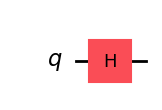
# This produces the unitary matrix
H = Operator(qc_H)
H.draw("latex")
Example: Z Gate#
The unitary matrix
encodes the \(Z\) gate.
qc_Z = QuantumCircuit(1)
qc_Z.z(0)
qc_Z.draw(output="mpl", style="iqp")
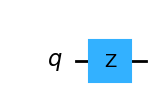
Z = Operator(qc_Z)
Z.draw("latex")
Example: Phase Gate#
We can also construct a phase gate that performs a rotation around the \(Z\) axis on the Bloch sphere by \(\lambda\) radians as in
qc_p = QuantumCircuit(1)
qc_p.p(np.pi, 0)
qc_p.draw(output="mpl", style="iqp")
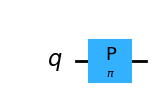
# A phase of 180 degrees is equivalent to a Z gate
def P(angle):
qc_p = QuantumCircuit(1)
qc_p.p(angle / 180 * np.pi, 0)
return Operator(qc_p)
P(180).draw("latex")
Gate Application is Matrix Multiplication#
The application of a gate \(G\) to a qubit \(|q\rangle\) is notated
and corresponds to the multiplication of the corresponding \(2 \times 2\) unitary matrix to the quantum state encoded by \(|q\rangle\).
Example#
Below, we show by example that matrix multiplication and the evolution of a quantum state under a gate are equivalent.
print("Matrix multiplication", np.array(Operator(qc_H)) @ np.array(zero))
(zero.evolve(Operator(qc_H))).draw('latex')
Matrix multiplication [0.70710678+0.j 0.70710678+0.j]
print("Matrix multiplication", np.array(Operator(qc_H)) @ np.array(one))
(one.evolve(Operator(qc_H))).draw('latex')
Matrix multiplication [ 0.70710678+0.j -0.70710678+0.j]
Unitary Matrix Review#
Unitary matrices have two properties that are important for quantum computing:
invertible and
norm preservation.
Invertibility and Reversibility#
Every unitary matrix is invertible. As a reminder, this means that for any unitary matrix \(U\), there exists another unitary matrix \(U^{-1}\) such that
where \(I\) is the identity matrix. This means that that quantum computations are reversible, since the application of a gate \(U\) can always be undone by another gate \(U^{-1}\).
# This demonstrates that H is its own inverse
(Operator(qc_H) @ Operator(qc_H)).draw("latex")
Conjugate Transpose#
For a unitary matrix, the inverse takes a special form: it is the conjugate transpose, i..e.,
(P(30) @ np.conj(P(30)).T).draw("latex")
Norm Preservation and Quantum Circuits#
Every unitary matrix preserves the norm of the input vector. In symbols,
# This demonstrates that H preserves the norm
np.linalg.norm(zero), np.linalg.norm(np.array(Operator(qc_H)) @ np.array(zero))
(np.float64(1.0), np.float64(0.9999999999999999))
Sequencing Gates#
The direct consequence of norm preservation is that applying a quantum gate to a single qubit produces an output that is also a qubit. This means that we can sequence the application of quantum gates to form a quantum computation as a quantum circuit. As a reminder, consider the circuit where we apply \(H\) followed by a \(Z\).
qc = QuantumCircuit(1)
qc.h(0)
qc.z(0)
qc.draw(output="mpl", style="iqp")

with PlotGateOpOnBloch() as ctx:
plot_bloch_vector(zero, ax=ctx.ax1, title="Before H-Z")
plot_bloch_vector(zero.evolve(Operator(qc)), ax=ctx.ax2, title="After H-Z")
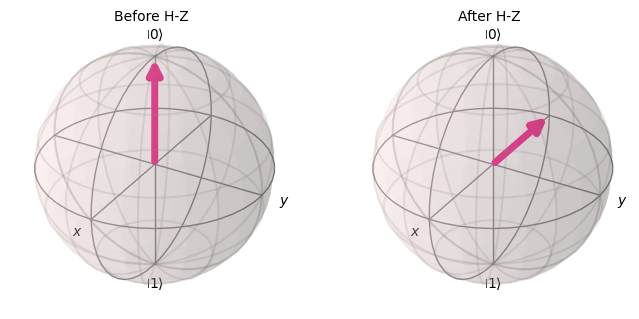
We can write the quantum circuit above using matrix multiplication as in
Norm preservation ensures that
\(\lVert H|0\rangle \rVert = \lVert |0\rangle \rVert\) and
\(\lVert Z(H|0\rangle) \rVert = \lVert H|0\rangle \rVert\).
Since \(\lVert |0\rangle \rVert = 1\), we have that \(\lVert Z(H|0\rangle) \rVert = 1\) as well, so we have a valid quantum state.
# Initial
zero.draw("latex")
# Apply H
q1 = zero.evolve(H)
q1.draw("latex")
# Apply Z
q_after = q1.evolve(Z)
q_after.draw("latex")
Aisde: Order of H and Z#
It may seem odd that the circuit is read left-to-right but the application of matrix multiplication was from right-to-left. However, forgetting quantum computation for a moment and considering in ordinary programming how we might apply \(H\) to an input, and then \(Z\), we’ll recognize that the order should be right-to-left.
def Z(x):
return 2 * x
def H(x):
return x + 1
print("Incorrect order for applying H, then Z:", H(Z(1)))
print("Correct order for apply H, then Z, is right-to-left:", Z(H(1)))
Incorrect order for applying H, then Z: 3
Correct order for apply H, then Z, is right-to-left: 4
Sequencing Gates corresponds to Matrix Multiplication#
Alternatively, we can simplify the sequence of gate applications to a single “gate” by multiplying all the gates together. For example,
The quantum state can then be calculated as
H = Operator(qc_H)
Z = Operator(qc_Z)
ZH = Z @ H
ZH.draw("latex")
# Apply ZH
zero.evolve(Z @ H).draw("latex")
Reversibility and Sequencing#
As we might guess, we can reverse the computation a sequence of gates performs by applying the inverse of each gate in reverse order.
qc = QuantumCircuit(1)
qc.h(0)
qc.p(np.pi / 3, 0)
qc.y(0)
qc.draw(output="mpl", style="iqp")
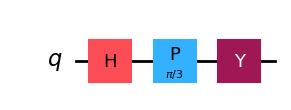
qc_rev = QuantumCircuit(1)
qc_rev.y(0) # Y is it's own inverse
qc_rev.p(-np.pi / 3, 0) # Rotate the other direction
qc_rev.h(0) # H is it's own inverse
qc_rev.draw(output="mpl", style="iqp")
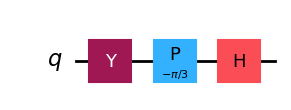
(Operator(qc) @ Operator(qc_rev)).draw("latex")
Gate-Based Quantum Computing#
In classical computation, we could encode an arbitrary truth table with circuits formed from a preselected set of gates (nand gates).
Similarly in gate-based quantum computing, we would try to encode an arbitrary transformation on a quantum state with quantum circuits from a preselected set of gates. In order to do this, we will need a universal gate set.
Summary#
We reviewed the connection between \(2 \times 2\) unitary matrices and gates that act on a single qubit system.
We saw that every quantum computation was reversible.
The preservation of norm ensures that we can sequence the application of quantum gates to form a quantum circuit.
